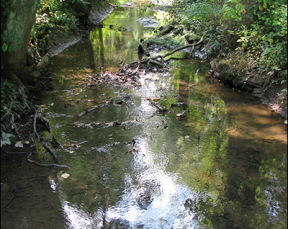July 15 was the inaugural day of GSWA’s first summer E. coli monitoring program. E. coli bacteria are found in the gut of warm blooded animals (including people, dogs, and birds). Some strains of E. coli can be harmful, but the varieties found in our local streams likely aren’t. However, E. coli indicate the presence of fecal matter, which could contain harmful viruses. Streams and ponds contaminated with fecal matter could make people or pets sick if we come in contact with it through swimming, kayaking, wading, or splashing.
Because of the potential health implications of high E. coli levels, sites were selected where human or pet contact with the water are common. Locations with official swimming beaches were not chosen because those sites are already monitored for E. coli under state regulations. There are a total of 17 sites located in all 5 watershed streams, several tributaries, and a few disconnected ponds. Click here for a map of sampling sites and here to view the descriptions of locations and results.
You may wonder how fecal matter could get into our streams in the first place. Most people immediately think of local wastewater treatment plants, however those plants must meet strict requirements for the amount of E. coli that they release in their effluent (generally zero). It is possible that sanitary sewer pipes are leaking, or septic systems aren’t functioning properly. Another potential source is animal waste — you may pick up after your dog, but others aren’t always so good about it. And no one picks up after the geese, deer, raccoons, and other wildlife living in the area.
The impacts from pets and wildlife are most noticeable after storms when rain carries fecal matter on land into the nearest body of water. For this reason, we would expect that water samples taken during or within a few days of a storm would have much higher E. coli levels than during dry periods.
Our first week’s samples were collected during storm conditions since at least 0.5” of rain fell in the 48 hours prior to sample collection (in this case, it was around 1.5” of rain). Sample results reflect the storm conditions, with 13 sites exceeding the state standard.
The second week’s samples were collected during dry conditions, when stormwater runoff wouldn’t contribute to bacteria levels. During that round of monitoring, 11 sites were within the state standard and all sites had lower E. coli levels than during the previous week.
The samples will be collected and analyzed for 3 additional weeks in order to see which sites have a persistent problem with high E. coli levels and which are just high during storms. Results will be posted here for the following 3 weeks of the program. If you have any questions you’d like answered in future posts, leave them in the comments!





